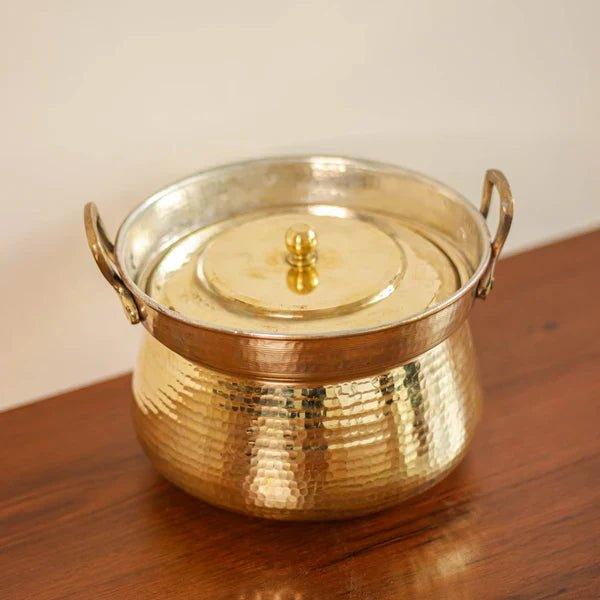In the age of modern conveniences and high-speed travel, it's fascinating to delve into the ingenious solutions crafted by our ancestors to meet the challenges of their times. One such remarkable invention is the "Rail Adukku", also known as "Kasi Pathram", a complete set of cookware designed by the skilled craftsmen of Tamil Nadu. This set, composed of brass and containing 14 essential vessels, is a testament to the resourcefulness and culinary heritage of the region.
The Origins of Rail Adukku
The Rail Adukku has its roots in the days when travel by road or rail was an arduous affair. Long journeys, whether for pilgrimage or other purposes, presented significant challenges, especially concerning food. Access to fresh meals was limited, and travelers needed a reliable way to prepare their own sustenance on the go. This necessity gave birth to the Rail Adukku, an innovative solution that allowed people to carry all the essential cooking vessels in a compact and easily transportable form.
Crafted from durable brass, known for its excellent heat conduction and longevity, the Rail Adukku set includes a variety of pots, pans, and utensils that nestle perfectly within one another, forming a single, larger container. This clever design made it possible for groups of travelers to carry their own kitchen, ensuring they could prepare meals wherever they stopped.
The Components of Rail Adukku

The traditional Rail Adukku set typically consists of the following vessels:
- Rice Pot: For cooking rice, a staple in South Indian cuisine.
- Curry Pot: Used for preparing various gravies and curries.
- Sarva Kadai: Essential for sautéing vegetables and frying items present in multiple sizes
- Water Pot: For storing and boiling water.
- Serving Bowls: Multiple sizes for serving different dishes.
Each of these items is meticulously designed to fit within the other, creating a compact and portable kitchen set. This not only made it easy to transport but also protected the vessels from damage during the journey.
Modern Relevance of Rail Adukku
In today's world, the Rail Adukku is not just a relic of the past but a practical solution for modern living. Here’s how this traditional cookware set finds its place in contemporary settings:
- Small Kitchens and Limited Storage Spaces
- For urban dwellers with compact kitchens, the Rail Adukku offers a space-saving solution. Its nesting design allows all essential cookware to be stored in a single, neat package, freeing up valuable kitchen space.
- Ancestral Homes and Vacation Houses
- Families who visit their ancestral homes or vacation houses occasionally can benefit from the Rail Adukku. Instead of maintaining a full kitchen setup that’s used infrequently, a Rail Adukku set provides all necessary cooking tools in one convenient package, perfect for temporary stays.
- Camping and Outdoor Cooking
- Outdoor enthusiasts and campers can also appreciate the practicality of the Rail Adukku. Its portability and comprehensive nature make it an excellent choice for preparing meals in the great outdoors.
- Cultural and Educational Value
- The Rail Adukku serves as a cultural artefact, preserving the culinary traditions of Tamil Nadu. It can be used in educational settings to teach about traditional Indian cooking methods and the history of regional craftsmanship.
Preserving a Legacy
As we embrace modernity, it’s essential to preserve the rich heritage and ingenious solutions of the past. The Rail Adukku stands as a symbol of Tamil Nadu's resourcefulness and culinary tradition. Whether used for its practical benefits in contemporary living or cherished as a piece of cultural history, the Rail Adukku continues to be an amazing testament to the timeless ingenuity of Indian craftsmen.
Incorporating the Rail Adukku into modern homes not only provides practical benefits but also connects us to our cultural roots, reminding us of the clever solutions our ancestors devised to make life easier. This traditional cookware set, with its blend of functionality and heritage, truly deserves a place in every home, offering a glimpse into a simpler, yet profoundly inventive past.




5 comments
suman
what price rail addakku? what are the details of its various components?
Deepali Dilip patil
I love tour products
Yamuna H R
I am looking for the price of rail adukku
H V R MURTHY
Good 👍
9848034771
aavudai manohaur
What’s the price of rail adukku..do u ve it with 14pieces only or do u ve one with 21
Leave a comment
All comments are moderated before being published.
This site is protected by hCaptcha and the hCaptcha Privacy Policy and Terms of Service apply.